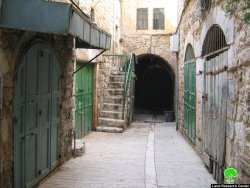Violation: the closure of Al Laban market entrance which leads to Bab al Khan and Al Sahla Neighborhoods.
Date: February 11, 2010.
Location: Hebron Old City.
Violators: the Israeli Occupation Army.
Victims: Palestinians residing in Hebron Old City.
Hebron Old City strangling policy conducted by the Israeli Occupation Authorities continue. On February 11, 2010, the Israeli Occupation Army sealed the entrance of Al Laban Market which leads to Bab al Khan and Al Sahla Neighborhoods in order to further divide the city.


x
Picture 1+2: the Iron wall placed by the Occupation forces in Al Laban Market
Sources in HRC (Hebron Rehabilitation Committee) stated that the Israeli Occupation Army sealed the entrance using iron plates without showing any reasons or issuing prior warnings. counting more than 112 gates, blockade, and earth mound this increases the total number of closed roads and entrances within the boundaries of the old city which. The purpose of such barriers is paralyzing merchandise and impeding the social interaction between the Palestinians living in the city.
Hebron Old City, extreme movement restrictions:
Downtown Hebron, which includes the Old city and named H2, is surrounded by several checkpoints in addition to numerous blockades (earth mounds and cement blocks) used to seal many paths within the city boundaries. Such Obstacles tremendously restricts movements within the city and to other parts of the city (areas named H1). Furthermore, farmers and merchants are unable to transfer goods to the Old City different markets, especially the vegetables market which has been closed since 2000.
Following the most recent closure, the Israeli Occupation Army denied the Palestinians from the ability to move between Al Laban Market and Al Qazazin Market. In addition, members of Al Rajabi clan living behind the Iron Gate have to change the route they used to take in order to get to other parts of the city.
Now, they are forced to take a longer and more dangerous path whenever they wish to leave the area. It is more dangerous because they have to pass near the Ibrahimi Mosque, an area full of Israeli Army Patrols in addition to the most aggressive, brutal, and extreme colonists in the West Bank.
Soundless Evacuation:
The intention of such closures and harassments against the Palestinians is forcing them to leave the old city in order to making expansion of the colonial nucleuses in the area a much easier task.
The wanderer in the old city cannot fail to notice the decreasing number of pedestrians whenever you move deeper in the Old City streets until people are seen no more. It is obvious that the closure policy conducted by the Israeli Occupation Authority is achieving its objectives.
Picture 3: Al Laban Market, people-free
Picture 4: Khuzq al Far Market, available goods but unavailable customers
The owner of the only shop still receiving customers in the area Mr. Abu Nidal al Jabrini stated: ‘the Israeli Occupation Army commotions in the area forced the shop keepers to close their shops. After the closure of the market entrance, I turned my shop into a meeting place of me and my friends; it’s not a shop any longer since there are not any customers especially the ones trapped behind the iron wall.’
Picture 5: Al Jabrini shop
It must be pointed that in 2002, the Israeli Occupation Army has closed another entrance of the market by placing an iron wall on the vegetables market entrance; thus separating it from Khuzq al Far market and al Sahla neighborhood
Picture 6: the iron wall separating Khuzq al Far market and al Sahla neighborhood from the vegetables market
Besides the movement limitations caused by the iron wall, the residents complained from the pooling of rain water behind the wall, the water closes the entrance of Nidal al ‘Iwewi house besides leaking into the shops.
Hebron City and Hebron Old City:
Hebron and Jerusalem are the only Palestinian cities with Israeli Jewish populations. Hebron City is inhabited by 163146 citizens. The total area of Hebron City is 50163 dunums (1 dunum = 1000 m2) including 23873 dunums of built-up area.
Within the boundaries of Hebron city lays the Old City (named H2). According to Oslo Agreement, it composes 20% of the total city area (4615 dunums) and is under full Israeli Control. Eight Israeli colonies lay within Hebron City and taking control of 2240.6 dunums of the total city area. 5 of these colonies lay inside Hebron Old City where 600 Israelis live under the protection of more than 1500 soldiers.
The colonies inside the frontier of the Old City are:
1. Beit Romano (previously Usama bin al Munqiz School)
2. Beit Hadasa (Aldaboya), it was established in 1980 and its total area is 18.5 dunums.
3. Ramat Yishai (Tal al Remeida), its total area is 65 dunums.
4. The Jewish Neighborhood, it was established in 1967 and its total area is around 66.6 dunums.
5. Abraham Avino, established in 1986 and its total area is 47.6 dunums.
The other colonies are:
1. Kiryat Arba: established in 1972, its total built-up area is 1173 inhabited by 6605 colonists.
2. Kharsina: established in 1983, its total built area is 812 dunums.
3. Haggai: established in 1984, its total built up area is 57.5 dunums inhabited by 388 colonists.
:::::::::__
[1] Source: GIS Unit at LRC

